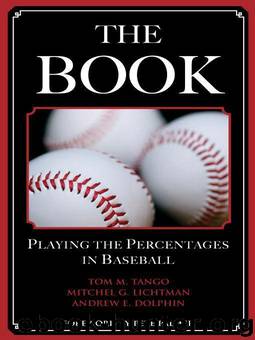The Book: Playing the Percentages in Baseball by Tom M. Tango

Author:Tom M. Tango [Tango, Tom M.]
Format: mobi
Publisher: Potomac Books Inc.
Published: 2007-03-10T08:00:00+00:00
The Three-Run Save
The primary motivation for modern bullpen strategy (or at least, how a team’s best reliever is used) is the save rule. The record books don’t make distinctions between the one-run save and the three-run save, but it’s rather clear that it’s much easier to save a three-run game than a one-run game. Nor do contracts make this distinction. If a reliever had a saves clause, he’d love to get in those three-run games, if only to make padding his saves that much easier. As well, relievers themselves may prefer a defined role that is based on the inning, rather than the leverage of the situation. They can appreciate the fact that there may be a situation in the seventh or eighth inning that can be a turning point for the game, but their conditioning prepares them only for the ninth inning (or perhaps two outs in the eighth inning).
There is also a psychological reason for managing according to the save rule. Blowing a three-run lead in the ninth inning, while deliberately keeping your ace reliever on the bench, would be a disastrous outcome. Media, fans, even a manager’s own players and upper management, will question and criticize such a move. Win today seems to be the motivation for the manager. We are not qualified to speak to the psychological impact. Neither, however, are most people. While we should not dismiss such claims, neither should we quickly embrace them without actually studying such claims. Most people are probably risk-averse, preferring a three-month treasury bill to a twelve-month government bond, even if you show them that in most three-month periods, the twelve-month government bond will yield higher returns. The potential for a negative return is enough for people to continue to pour money into such safe investment vehicles as the short-term treasury bills. At the same time, no one will question the manager if he lets his ace sit on the bench at a very critical moment in the game, if that moment occurs in the seventh inning. After all, an even more critical moment may come in the ninth inning. And, what happens in those times when it doesn’t come? Perhaps the true motivation of the manager is win today, but don’t try to win too early in the game.
How easy are three-run leads, and should you use your best reliever in those situations? Do you want to bring him in, and risk not having him available for the next game; or do you bring in your second- or third-best reliever, reduce your chances of winning this game, and potentially increase your chances of winning tomorrow? Here we are, in the information age, and the managers still operate almost exclusively on instincts. Instincts are valuable if you don’t have all the data and time you need to make a decision. Your experience and wisdom will control your decisions when your instincts need to be kicked in. But, the three-run lead? You have plenty of time to formulate your thinking. And, there’s plenty of data to assist.
Download
This site does not store any files on its server. We only index and link to content provided by other sites. Please contact the content providers to delete copyright contents if any and email us, we'll remove relevant links or contents immediately.
Machine Learning at Scale with H2O by Gregory Keys | David Whiting(3653)
Never by Ken Follett(3545)
Liar's Poker by Michael Lewis(3230)
The Ultimate Backcountry Survival Manual by Aram Von Benedikt; Editors of Outdoor Life;(3172)
Will by Will Smith(2589)
The Partner by John Grisham(2286)
Friends, Lovers, and the Big Terrible Thing by Matthew Perry(2012)
Can't Hurt Me: Master Your Mind and Defy the Odds - Clean Edition by David Goggins(2008)
Taste by Kris Bryant(1806)
HBR's 10 Must Reads 2022 by Harvard Business Review(1702)
A Short History of War by Jeremy Black(1677)
Never Finished: Unshackle Your Mind and Win the War Within by David Goggins(1562)
The Arm by Jeff Passan(1527)
515945210 by Unknown(1524)
The Dodgers by Schiavone Michael;(1478)
The Yogi Book by Yogi Berra(1426)
443319537 by Unknown(1400)
A Game of Thrones (The Illustrated Edition) by George R. R. Martin(1374)
1942266391 (N) by Monte Francis(1372)
